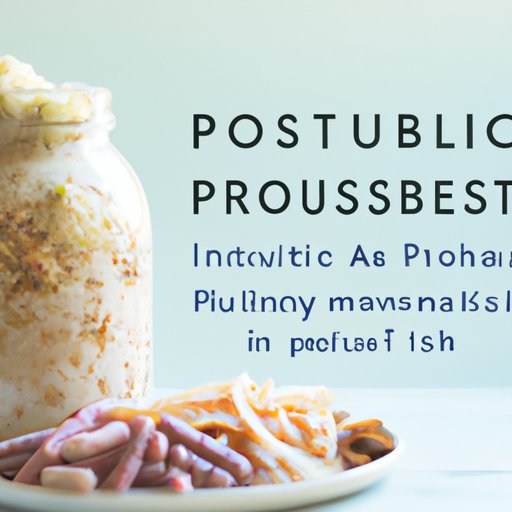Introduction
Live cultures are microorganisms that are found naturally in food and beneficial to our health. These organisms provide numerous benefits, such as improved digestion, increased nutrient absorption, and better immunity. In this article, we’ll explore the benefits of live cultures and how to incorporate them into your diet.
Exploring the Benefits of Live Cultures
Live cultures offer many benefits for our health, including improved digestion and gut health, increased nutrient absorption, and improved immunity. Let’s take a closer look at each one.
Improved Digestion and Gut Health
Live cultures help improve digestion by increasing the production of digestive enzymes. They also help break down food more efficiently, which makes it easier for the body to absorb the nutrients. Additionally, live cultures have been shown to reduce inflammation in the gut, which can lead to improved overall digestive health.
Increased Nutrient Absorption
Live cultures can also help increase the absorption of key nutrients, such as vitamins, minerals, and antioxidants. This helps ensure that the body is getting all the essential nutrients it needs to function properly. According to a study published in the Journal of Nutrition, “Probiotic bacteria might be useful in increasing the bioavailability of certain minerals and vitamins.”
Improved Immunity
Live cultures can help boost the immune system by increasing the number of beneficial bacteria in the gut. This helps to protect the body from harmful bacteria and viruses, as well as reducing inflammation. A study published in the journal Clinical Reviews in Allergy & Immunology found that “probiotics may be effective in preventing or ameliorating several immune-related diseases.”

A Closer Look at Types of Live Cultures
Live cultures come in three main forms: probiotics, prebiotics, and fermented foods. Let’s take a closer look at each one.
Probiotics
Probiotics are live microorganisms that are found in certain foods, such as yogurt, kefir, and sauerkraut. They help to maintain a healthy balance of bacteria in the gut and support digestive health. Probiotics are often referred to as “good” bacteria because they help to protect the body from harmful bacteria and viruses.
Prebiotics
Prebiotics are non-digestible carbohydrates that act as food for probiotics. They are found in certain fruits and vegetables, such as bananas, onions, garlic, and asparagus. Prebiotics help to nourish the good bacteria in the gut, which helps to keep the digestive system functioning optimally.
Fermented Foods
Fermented foods are foods that have been through a process of fermentation, which uses bacteria or yeast to convert carbohydrates into alcohol or acids. Examples of fermented foods include kimchi, kombucha, and pickles. Fermented foods are rich in probiotics and can help to promote a healthy balance of bacteria in the gut.

How to Incorporate Live Cultures into Your Diet
Incorporating live cultures into your diet is simple and can be done in a few easy steps. Here are some tips for adding live cultures to your meals.
Choose Probiotic-Rich Foods
One of the easiest ways to get more probiotics into your diet is to choose probiotic-rich foods, such as yogurt, kefir, sauerkraut, and kimchi. You can also find probiotic supplements at most health food stores.
Include Prebiotic-Rich Foods
In addition to probiotic-rich foods, you should also include prebiotic-rich foods in your diet. These foods, such as bananas, onions, garlic, and asparagus, help to nourish the good bacteria in the gut.
Consume Fermented Foods
Fermented foods are also a great way to get more probiotics into your diet. Examples of fermented foods include kimchi, kombucha, and pickles. These foods are rich in probiotics and can help to promote a healthy balance of bacteria in the gut.
Understanding the Health Benefits of Live Cultures
Live cultures offer many health benefits, such as improved digestive system function, reduced risk of disease, and improved immune system function. Let’s take a closer look at each one.
Improved Digestive System Function
Live cultures help to improve digestive system function by increasing the production of digestive enzymes, breaking down food more efficiently, and reducing inflammation in the gut. This helps the body to absorb the nutrients it needs more effectively.
Reduced Risk of Disease
Live cultures can help to reduce the risk of certain diseases by helping to maintain a healthy balance of bacteria in the gut. This can help to protect the body from harmful bacteria and viruses, as well as reducing inflammation.
Improved Immune System Function
Live cultures can also help to improve the function of the immune system by increasing the number of beneficial bacteria in the gut. This helps to protect the body from illnesses and infections and can help to reduce inflammation.

The Role of Fermentation in Live Cultures
Fermentation is an important part of live cultures. It is a process that uses bacteria or yeast to convert carbohydrates into alcohol or acids. This process helps to preserve food and can also create beneficial compounds, such as probiotics, which can help to promote a healthy balance of bacteria in the gut.
What Are the Different Types of Live Cultures?
There are three main types of live cultures: bifidobacteria, lactobacilli, and streptococcus. Bifidobacteria are the most abundant type of beneficial bacteria in the gut, while lactobacilli are commonly found in fermented foods. Streptococcus is a type of bacteria that helps to break down food, making it easier for the body to absorb the nutrients.
Conclusion
Live cultures offer many health benefits, such as improved digestion, increased nutrient absorption, and better immunity. They come in three forms: probiotics, prebiotics, and fermented foods. To get the most out of live cultures, it is important to include a variety of probiotic-rich foods, prebiotic-rich foods, and fermented foods in your diet. By doing so, you can help to ensure that your body is getting all the essential nutrients it needs to function properly and stay healthy.
(Note: Is this article not meeting your expectations? Do you have knowledge or insights to share? Unlock new opportunities and expand your reach by joining our authors team. Click Registration to join us and share your expertise with our readers.)
